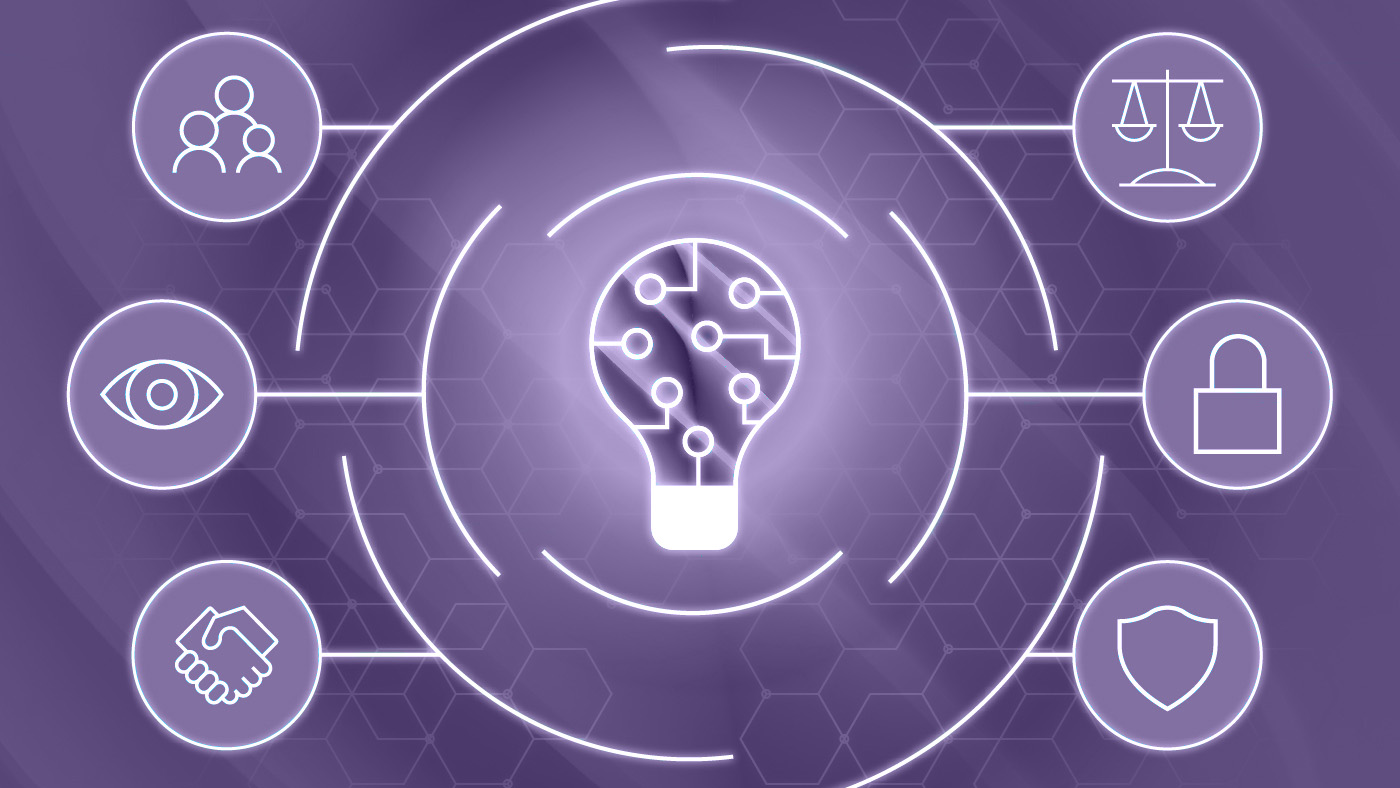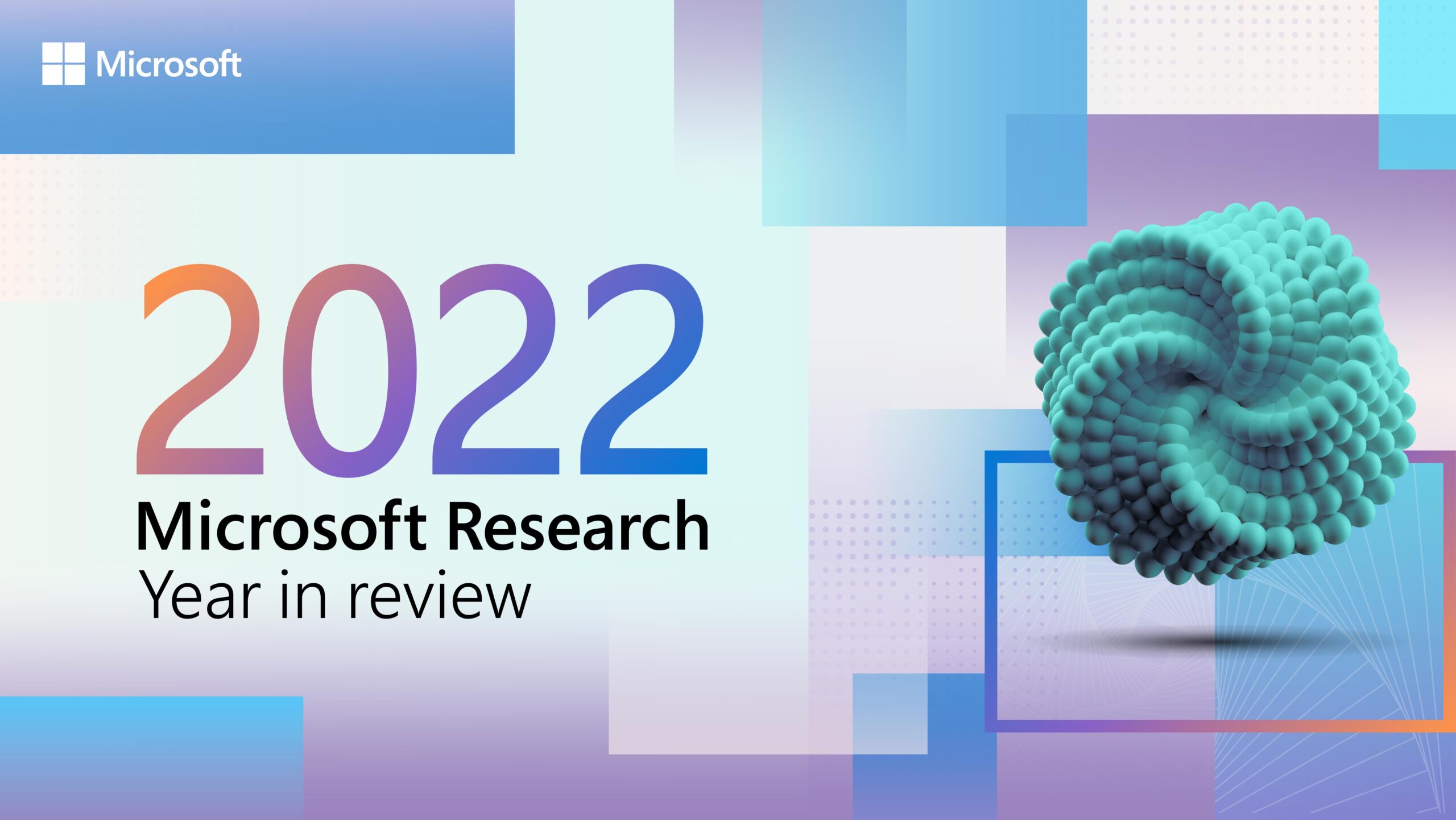
It isn’t often that researchers at the cutting edge of technology see something that blows their minds. But that’s exactly what happened in 2023, when AI experts began interacting with GPT-4, a large language model (LLM) created by researchers at OpenAI that was trained at unprecedented scale.
“I saw some mind-blowing capabilities that I thought I wouldn’t see for many years,” said Ece Kamar, partner research manager at Microsoft, during a podcast recorded in April.
Throughout the year, rapid advances in AI came to dominate the public conversation (opens in new tab), as technology leaders and eventually the general public voiced a mix of wonder and skepticism after experimenting with GPT-4 and related applications. Could we be seeing sparks of artificial general intelligence (opens in new tab)—informally defined as AI systems that “demonstrate broad capabilities of intelligence, including reasoning, planning, and the ability to learn from experience (opens in new tab)”?
While the answer to that question isn’t yet clear, we have certainly entered the era of AI, and it’s bringing profound changes to the way we work and live. In 2023, AI emerged from the lab and delivered everyday innovations that anyone can use. Millions of people now engage with AI-based services like ChatGPT. Copilots (opens in new tab)—AI that helps with complex tasks ranging from search to security—are being woven into business software and services.
Underpinning all of this innovation is years of research, including the work of hundreds of world-class researchers at Microsoft, aided by scientists, engineers, and experts across many related fields. In 2023, AI’s transition from research to reality began to accelerate, creating more tangible results than ever before. This post looks back at the progress of the past year, highlighting a sampling of the research and strategies that will support even greater progress in 2024.
Strengthening the foundations of AI
AI with positive societal impact is the sum of several integral moving parts, including the AI models, the application of these models, and the infrastructure and standards supporting their development and the development of the larger systems they underpin. Microsoft is redefining the state of the art across these areas with improvements to model efficiency, performance, and capability; the introduction of new frameworks and prompting strategies that increase the usability of models; and best practices that contribute to sustainable and responsible AI.
Advancing models
- Researchers introduced Retentive Networks (RetNet), an alternative to the dominant transformer architecture in language modeling. RetNet supports training parallelism and strong performance while making significant gains in inference efficiency.
- To contribute to more computationally efficient and sustainable language models, researchers presented a 1-bit transformer architecture called BitNet.
- Microsoft expanded its Phi family of small language models with the 2.7 billion-parameter Phi-2, which raises the bar in reasoning and language understanding among base models with up to 13 billion parameters. Phi-2 also met or exceeded the performance of models 25 times its size on complex benchmarks.
- The release of the language models Orca (13 billion parameters) and, several months later, Orca 2 (7 billion and 13 billion parameters) demonstrates how improved training methods, such as synthetic data creation, can elevate small model reasoning to a level on par with larger models.
- For AI experiences that more closely reflect how people create across mediums, Composable Diffusion (CoDi) takes as input a mix of modalities, such as text, audio, and image, and produces multimodal output, such as video with synchronized audio.
- To better model human reasoning and speed up response time, the new approach Skeleton-of-Thought has LLMs break tasks down into two parts—creating an outline of a response and providing details on each point in parallel.
Advancing methods for model usage
- AutoGen is an open-source framework for simplifying the orchestration, optimization, and automation of LLM workflows to enable and streamline the creation of LLM-based applications.
- Medprompt, a composition of prompting strategies, demonstrates that with thoughtful and advanced prompting alone, general foundation models can outperform specialized models, offering a more efficient and accessible alternative to fine-tuning on expert-curated data.
- The resource collection promptbase offers prompting techniques and tools designed to help optimize foundation model performance, including Medprompt, which has been extended for application outside of medicine.
- Aimed at addressing issues associated with lengthy inputs, such as increased response latency, LLMLingua is a prompt-compression method that leverages small language models to remove unnecessary tokens.
Developing and sharing best practices
- Microsoft announced the Microscaling (MX) Alliance (opens in new tab) with several industry partners and unveiled the industry’s first open data format aimed at enabling sub-8-bit training and inference for AI models, helping to pave the way for more efficient and scalable deep learning.
- Continuing to advance the responsible development of AI in its own practices and industrywide, Microsoft supported the White House’s voluntary AI commitments. Meanwhile, members across the company’s research community continued to carefully examine model capabilities and limitations and study the identification, measurement, and mitigation of AI harms, including in the area of multimodal AI. They also prioritized transparency as a cornerstone of responsible, human-centered AI, including through co-auditing tools for assessing the accuracy of AI-generated content.
Accelerating scientific exploration and discovery
Microsoft uses AI and other advanced technologies to accelerate and transform scientific discovery, empowering researchers worldwide with leading-edge tools. Across global Microsoft research labs, experts in machine learning, quantum physics, molecular biology, and many other disciplines are tackling pressing challenges in the natural and life sciences.
- Because of the complexities arising from multiple variables and the inherently chaotic nature of weather, Microsoft is using machine learning to enhance the accuracy of subseasonal forecasts.
- Distributional Graphormer (DIG) is a deep learning framework for predicting protein structures with greater accuracy, a fundamental problem in molecular science. This advance could help deliver breakthroughs in critical research areas like materials science and drug discovery.
- Leveraging evolutionary-scale protein data, the general-purpose diffusion framework EvoDiff helps design novel proteins more efficiently, which can aid in the development of industrial enzymes, including for therapeutics.
- MOFDiff, a coarse-grained diffusion model, helps scientists refine the design of new metal-organic frameworks (MOFs) for the low-cost removal of carbon dioxide from air and other dilute gas streams. This innovation could play a vital role in slowing climate change.
- This episode of the Microsoft Research Podcast series Collaborators explores research into renewable energy storage systems, specifically flow batteries, and discusses how machine learning can help to identify compounds ideal for storing waterpower and advancing carbon capture.
- MatterGen is a diffusion model specifically designed to address the central challenge in materials science by efficiently generating novel, stable materials with desired properties, such as high conductivity for lithium-ion batteries.
- Deep learning is poised to revolutionize the natural sciences, enhancing modeling and prediction of natural occurrences, ushering in a new era of scientific exploration, and leading to significant advances in sectors ranging from drug development to renewable energy. DeepSpeed4Science, a new Microsoft initiative, aims to build unique capabilities through AI system technology innovations to help domain experts unlock today’s biggest science mysteries.
- Christopher Bishop, Microsoft technical fellow and director of the AI4Science team, recently published Deep Learning: Foundations and Concepts, a book that “offers a comprehensive introduction to the ideas that underpin deep learning.” Bishop discussed the motivation and process behind the book, as well as deep learning’s impact on the natural sciences, in the AI Frontiers podcast series.
Maximizing the individual and societal benefits of AI
As AI models grow in capability so, too, do opportunities to empower people to achieve more, as demonstrated by Microsoft work in such domains as health and education this year. The company’s commitment to positive human impact requires that AI technology be equitable and accessible.
- Peter Lee, corporate vice president of Research and Incubations at Microsoft, explored the potential of LLMs and the systems they drive to impact healthcare in ways that haven’t been possible for previous AI advancements. He and coauthors examine GPT-4 in the book The AI Revolution in Medicine: GPT-4 and Beyond and in the New England Journal of Medicine “AI in Medicine” special report.
- Researchers continued to advance AI’s application in radiology, testing the boundaries of GPT-4 in the field. They also introduced a vision-language pretraining framework enabling alignment between text and multiple radiology images and a multimodal model for generating radiological reports.
- Microsoft efforts in the radiology space are already supporting real-world results, with its research contributing to an AI system developed by a UK hospital (opens in new tab) that is helping cancer patients begin treatment more quickly (opens in new tab).
- Researchers showed that LLM-enabled copilots can help facilitators of peer support chat groups consisting of patients and providers draft educational content for members, track long discussions with message summarization, and identify misinformation or harmful advice, strengthening online health communities as a source of information and support.
- A pilot program for the research project Shiksha copilot, an AI-powered digital assistant, is helping teachers in India create comprehensive, age-appropriate lesson plans significantly faster, opening up time for more student mentoring and professional development.
- Shiksha copilot is part of a larger effort, called Project VeLLM, to help people of all languages and cultures take advantage of the benefits offered by LLMs, including through improving models on non-English languages. Corporate Vice President and Managing Director of Microsoft Research India Sriram Rajamani talked about the project and other work in the lab’s technology and empowerment focus area.
Beyond AI: Leading technology innovation
While AI rightly garners much attention in the current research landscape, researchers at Microsoft are still making plenty of progress across a spectrum of technical focus areas.
- Project Silica, a cloud-based storage system underpinned by quartz glass, is designed to provide sustainable and durable archival storage that’s theoretically capable of lasting thousands of years.
- Project Analog Iterative Machine (AIM) aims to solve difficult optimization problems—crucial across industries such as finance, logistics, transportation, energy, healthcare, and manufacturing—in a timely, energy-efficient, and cost-effective manner. Its designers believe Project AIM could outperform even the most powerful digital computers.
- Microsoft researchers proved that 3D telemedicine (3DTM), using HoloportationTM communication technology, could help improve healthcare delivery, even across continents, in a unique collaboration with doctors and governments in Scotland and Ghana.
- In another collaboration that aims to help improve precision medicine, Microsoft worked with industry and academic colleagues to release Terra, a secure, centralized, cloud-based platform for biomedical research on Microsoft Azure.
- On the hardware front, Microsoft researchers are exploring sensor-enhanced headphones, outfitting them with controls that use head orientation and hand gestures to enable context-aware privacy, gestural audio-visual control, and animated avatars derived from natural body language.
Collaborating across academia, industries, and disciplines
Cross-company and cross-disciplinary collaboration has always played an important role in research and even more so as AI continues to rapidly advance. Large models driving the progress are components of larger systems that will deliver the value of AI to people. Developing these systems and the frameworks for determining their roles in people’s lives and society requires the knowledge and experience of those who understand the context in which they’ll operate—domain experts, academics, the individuals using these systems, and others.
- The research project Find My Things, an application to help people who are blind or low vision find personal items, brought together researchers and citizen designers to demonstrate how AI experiences can be personalized to suit people’s individual needs, an approach referred to as Teachable AI.
- Product, research, and incubation teams at Microsoft continued working together to make tools for the responsible development of AI available to customers and the open-source community, adding the Responsible AI Mitigations Library and the Responsible AI Tracker to the company’s Responsible AI Toolbox in February.
- Researchers at Microsoft collaborated with researchers within the psychology subfield of psychometrics to explore how the science of psychological measurement can help evaluate model performance as AI models become more general purpose.
- Responsible AI researchers and applied scientists expanded a framework they had been working on for measuring fairness-related harms in AI systems to accommodate novel scenarios presented by the incorporation of GPT-4 into Bing.
- Researchers presented a framework for thinking about the impact of generative AI on how people communicate and a collection of strategies for meeting challenges.
- Microsoft Research established the Accelerate Foundation Models Research (AFMR) global network and resource platform (opens in new tab) to assemble an interdisciplinary research community around solving some of today’s greatest technical and societal challenges through aligning AI with shared human goals, values, and preferences; improving human-AI interactions; and accelerating scientific discoveries. In line with Microsoft support of the White House’s responsible AI voluntary commitments, AFMR (opens in new tab) grants provide access to state-of-the-art foundation models to make sure researchers outside the company can appropriately examine cutting-edge model applications (opens in new tab) and their impact. To date, access to leading foundation models has been extended to more than 190 principal investigators from over 100 institutions from around the world.
- The Microsoft Research AI & Society fellows program was created to bring together scholars and leading experts from across the arts and sciences to tackle the challenges and opportunities at the intersection of AI and society—from copyright protection in the era of LLMs to reducing digital divides in the Global South. The program received nearly 3,000 proposals across its 13 challenges during its inaugural call this fall, and selected fellows will be announced in January 2024.
Engaging and supporting the larger research community
Throughout the year, Microsoft continued to engage with the broader research community on AI and beyond. The company’s sponsorship of and participation in key conferences not only showcased its dedication to the application of AI in diverse technological domains but also underscored its unwavering support for cutting-edge advancements and collaborative community involvement.
Functional programming
- Microsoft was a proud sponsor of ICFP 2023, with research contributions covering a range of functional programming topics, including memory optimization, language design, and software-development techniques.
Human-computer interaction
- At CHI 2023, Microsoft researchers and their collaborators demonstrated the myriad and diverse ways people use computing today and will in the future.
Large language models and ML
- Microsoft was a sponsor of ACL 2023, showcasing papers ranging from fairness in language models to natural language generation and beyond.
- Microsoft also sponsored NeurIPS 2023, publishing over 100 papers and conducting workshops on language models, deep learning techniques, and additional concepts, methods, and applications addressing pressing issues in the field.
- With its sponsorship of and contribution to ICML 2023, Microsoft showcased its investment in advancing the field of machine learning.
- Microsoft sponsored ML4H (opens in new tab) and participated in AfriCHI (opens in new tab) and EMNLP (opens in new tab), a leading conference in natural language processing and AI, highlighting its commitment to exploring how LLMs can be applied to healthcare and other vital domains.
Systems and advanced networking
- Microsoft research contributions at SOSP 2023, a conference it sponsored, ranged from operating systems and cloud computing to mobile and edge systems.
- As a sponsor of USENIX NDSI 2023, Microsoft reinforced its commitment to advancing networking and distributed systems, with accepted papers covering such diverse topics as AI workload networking, cloud, WAN, and wireless networks, displaying cutting-edge advancements in networking research.
- Microsoft was a strong participant at EuroSys 2023, Europe’s premier systems conference, highlighting developments in systems innovation across the stack to help support an easier, faster, safer, and smarter cloud.
- As a sponsor of SIGCOMM 2023, Microsoft shared its innovations on the foundational network infrastructure that underpins the cloud ecosystem.
- From contributions to generative models and network pretraining to sign language understanding and neural video codecs, the company’s participation in CVPR 2023 underscores its commitment to evolving the capabilities of systems to analyze and extract valuable insights from visual data.
Listeners’ choice: Notable podcasts for 2023
- AI Frontiers: The future of causal reasoning with Emre Kiciman and Amit Sharma
- AI Frontiers: AI for health and the future of research with Peter Lee
- AI Frontiers: Models and Systems with Ece Kamar
- AI Frontiers: AI in India and beyond with Sriram Rajamani
- AI Frontiers: The Physics of AI with Sébastien Bubeck
- AI Frontiers: Measuring and mitigating harms with Hanna Wallach
- AI Frontiers: The future of scale with Ahmed Awadallah and Ashley Llorens
- Collaborators: Gov4git with Petar Maymounkov and Kasia Sitkiewicz
- Collaborators: Gaming AI with Haiyan Zhang
- Collaborators: Renewable energy storage with Bichlien Nguyen and David Kwabi
- Collaborators: Data-driven decision-making with Jina Suh and Shamsi Iqbal
- Collaborators: Holoportation™ communication technology with Spencer Fowers and Kwame Darko
- Collaborators: Project InnerEye with Javier Alvarez and Raj Jena
- What’s Your Story: Ranveer Chandra
- Abstracts: September 13, 2023, EvoDiff
Thank you for reading
Microsoft achieved extraordinary milestones in 2023 and will continue pushing the boundaries of innovation to help shape a future where technology serves humanity in remarkable ways. To stay abreast of the latest updates, subscribe to the Microsoft Research Newsletter (opens in new tab) and the Microsoft Research Podcast (opens in new tab). You can also follow us on Facebook (opens in new tab), Instagram (opens in new tab), LinkedIn (opens in new tab), X (opens in new tab), and YouTube (opens in new tab).
Writers, Editors, and Producers
Kristina Dodge
Kate Forster
Jessica Gartner
Alyssa Hughes
Gretchen Huizinga
Brenda Potts
Chris Stetkiewicz
Larry West
Managing Editor
Amber Tingle
Project Manager
Amanda Melfi
Microsoft Research Global Design Lead
Neeltje Berger
Graphic Designers
Adam Blythe
Harley Weber
Microsoft Research Creative Studio Lead
Matt Corwine




